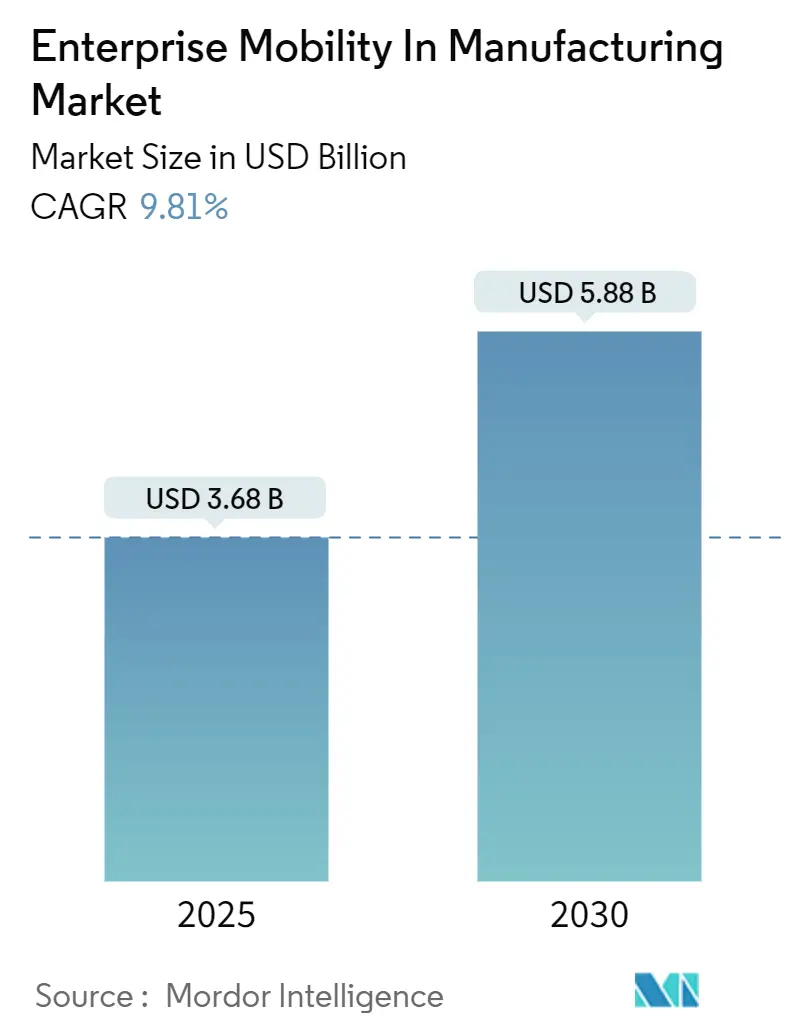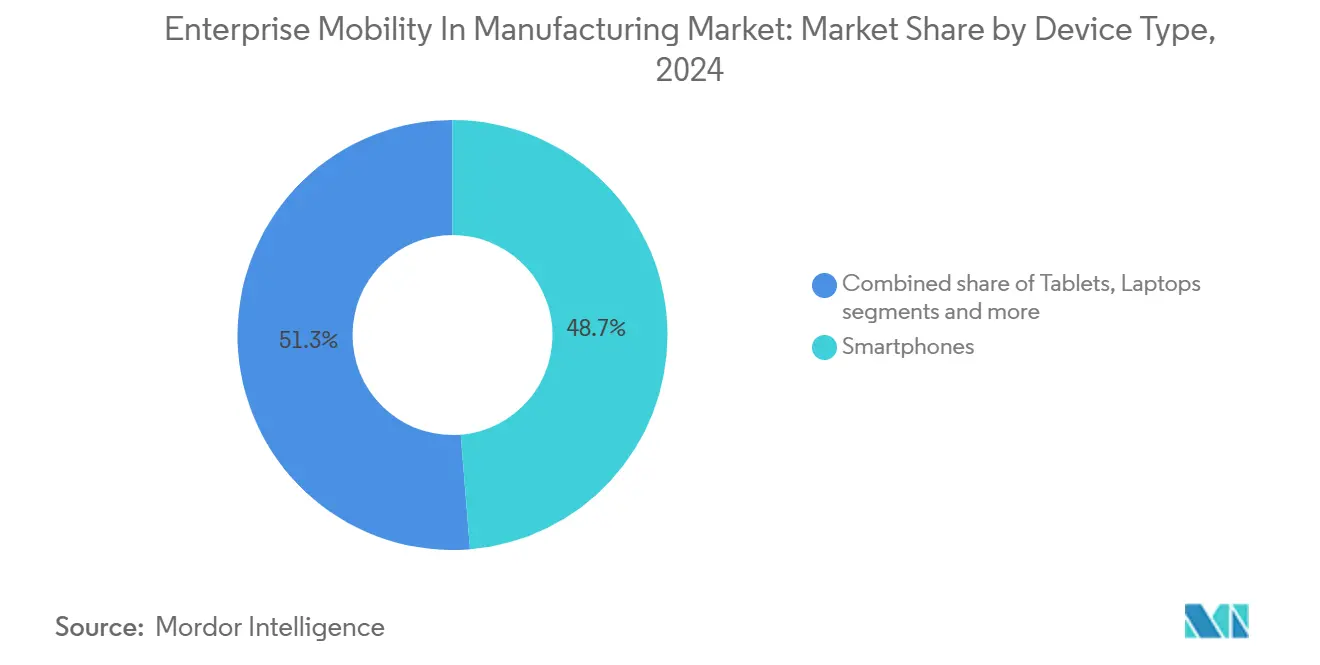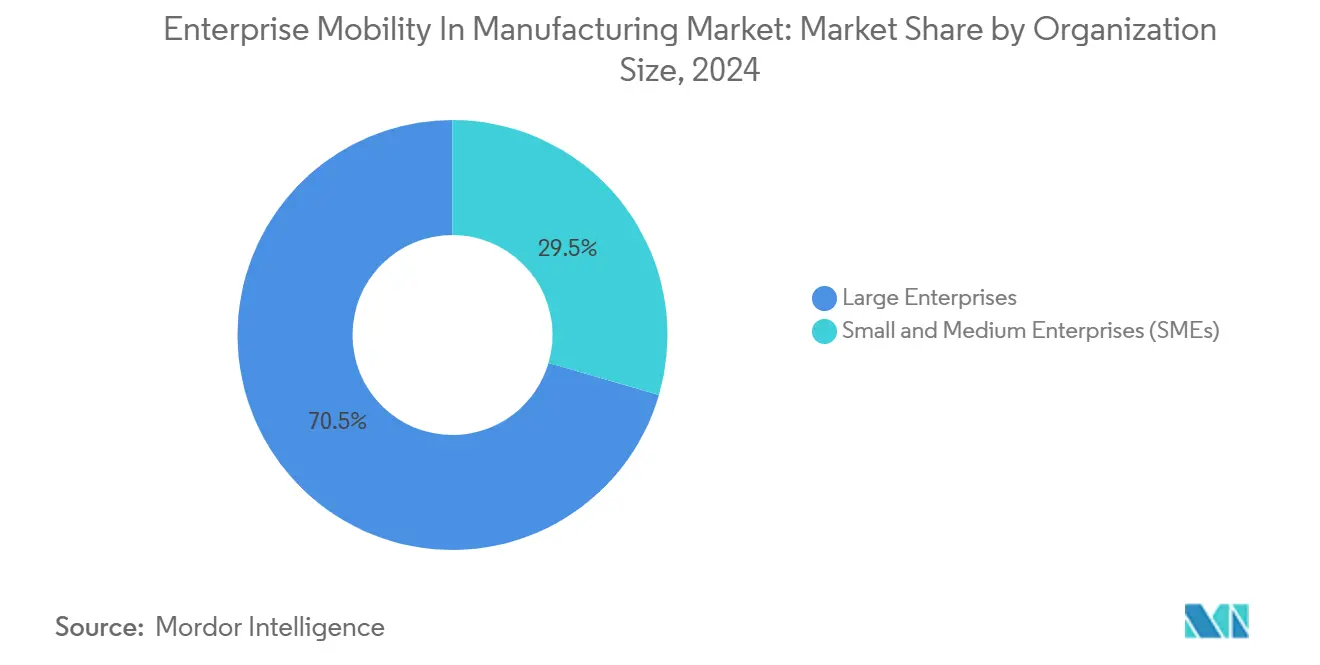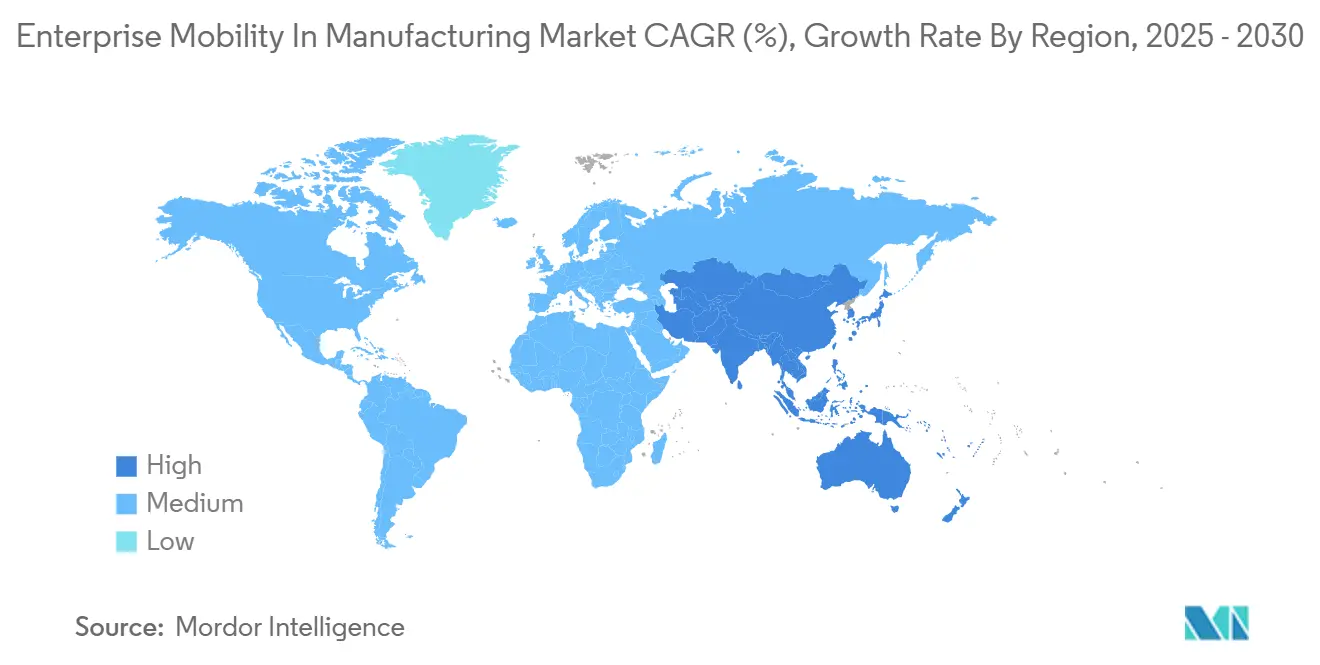Enterprise Mobility In Manufacturing Market Size and Share

Enterprise Mobility In Manufacturing Market Analysis by Mordor Intelligence
The enterprise mobility in manufacturing market size was USD 3.68 billion in 2025 and is forecast to reach USD 5.88 billion by 2030, expanding at a 9.8% CAGR. The uptrend mirrors the sector’s rapid transition toward Industry 4.0, where mobile-enabled workflows shorten response times, elevate asset visibility, and reinforce operational resilience. Growing deployment of private 5G networks, tighter integration between mobile devices and Manufacturing Execution Systems (MES), and the spread of edge-based augmented-reality applications collectively widen use cases for shop-floor mobility. Yet only 16% of manufacturers enjoy real-time production visibility, underscoring the sizeable headroom for digital tools that dissolve long-standing information silos. Cyber-physical security gaps and data-sovereignty constraints temper adoption, pushing vendors toward zero-trust architectures and region-specific cloud strategies.
Key Report Takeaways
- By device type, smartphones captured 48.7% of the enterprise mobility in manufacturing market share in 2024, whereas wearables are advancing at a 9.9% CAGR through 2030.
- By solution, Mobile Device Management accounted for 46.2% share of the enterprise mobility in manufacturing market size in 2024; Unified Endpoint Management is rising at a 10.1% CAGR to 2030.
- By deployment mode, on-premise installations held 67.8% share in 2024, while cloud deployments are scaling at an 11.5% CAGR to 2030.
- By organization size, large enterprises dominated with 70.5% share in 2024; small and medium enterprises (SMEs) are forecast to grow at an 11.2% CAGR during 2025-2030.
- By manufacturing vertical, discrete manufacturing commanded 68.9% of the enterprise mobility in manufacturing market size in 2024; process manufacturing is on track for a 10.6% CAGR.
- By geography, North America led with 39.1% revenue share in 2024, whereas Asia-Pacific is projected to grow at a 10.4% CAGR.
Global Enterprise Mobility In Manufacturing Market Trends and Insights
Drivers Impact Analysis
| Driver | (~) % Impact on CAGR Forecast | Geographic Relevance | Impact Timeline |
|---|---|---|---|
| Accelerating Industry 4.0 and IIoT adoption | +2.1% | Global, early gains in Germany, China, South Korea | Medium term (2-4 years) |
| BYOD/CYOD policies expand connected workforce | +1.8% | North America & EU, spill-over to APAC | Short term (≤ 2 years) |
| Private 5G and Wi-Fi 6 enable low-latency mobility | +1.5% | APAC core, expanding to North America | Medium term (2-4 years) |
| Integration of mobile devices with MES and cloud PLM | +1.3% | Global, automotive & electronics hubs | Long term (≥ 4 years) |
| Edge-powered AR and digital twins boost rugged-tablet demand | +1.2% | North America, Germany, Japan | Medium term (2-4 years) |
| Paperless ESG compliance drives mobile e-logbooks | +0.9% | EU leading, North America following | Long term (≥ 4 years) |
| Source: Mordor Intelligence | |||
Accelerating Industry 4.0 and IIoT adoption
Manufacturers are scaling Industrial Internet of Things deployments from proof-of-concept projects to plant-wide rollouts, linking sensors, machines, and mobile endpoints into unified data loops. Eighty-three percent of producers intend to embed generative AI in decision support during 2024, reflecting confidence that mobile dashboards can operationalize complex analytics at the edge[1]Rockwell Automation, “State of Smart Manufacturing Report 2024,” rockwellautomation.com. The pronounced impact shows in process plants where mobile cyber-physical systems let operators tweak parameters remotely in minutes rather than hours. Asian factories lead readiness, with 53% of managers targeting autonomous operations by 2040 compared to under half in Western facilities. Increased IIoT maturity lifts demand for rugged smartphones that merge scanning, visualization, and voice in a single device, streamlining maintenance and quality tasks. Vendors in the enterprise mobility in manufacturing market that pre-integrate hardware with low-code app builders shorten deployment cycles and reduce IT overhead.
BYOD/CYOD policies expand connected workforce
Factory policies are shifting from restrictive device rules toward structured Bring-Your-Own-Device and Choose-Your-Own-Device programs that broaden workforce access to digital tools. Sixty-three percent of manufacturers already tolerate personal devices on the floor, yet only 17% run formal BYOD frameworks, signalling a wide adoption gap. Formalized schemes improve agility during labor shortages by allowing new hires to onboard with familiar gear. Samsung’s eight-step CYOD blueprint highlights the need for executive sponsorship, risk-based segmentation, and user training to safeguard data while sustaining productivity. Successful rollouts embed enterprise credentials into secure containers, route traffic through zero-trust gateways, and synchronize with MES and ERP back ends. Early adopters report shorter shift handovers and lower provisioning costs relative to a corporate-only hardware fleet.
Private 5G and Wi-Fi 6 enable low-latency mobility
Dedicated cellular networks inside factories eliminate the contention and roaming delays that hamper legacy Wi-Fi, delivering deterministic sub-10 ms latency for automated guided vehicles and safety interlocks. Deployments show double-digit throughput gains and sharper positioning accuracy, enabling mobile human-machine interfaces (HMIs) to handle time-critical controls formerly restricted to fixed panels. Hybrid 5G/Wi-Fi 6 architectures segment traffic by need: 5G handles tele-robotics and vision-guided lifting, while Wi-Fi serves label printing and engineering collaboration. Early adopters record fewer production halts and higher overall equipment effectiveness, validating the investment case for spectrum licenses and edge cores. Equipment vendors are now bundling private-network starter kits with mobile apps and analytics subscriptions to simplify entry for midsize plants.
Integration of mobile devices with MES and cloud PLM
Linking smartphones and tablets to Manufacturing Execution Systems delivers real-time production KPIs, electronic batch records, and digital work instructions directly to frontline staff. Companies that paired mobile interfaces with MES experienced 30% administrative time savings and USD 2.2 million operator productivity gains in year one. Discrete manufacturers add further value by feeding in-process quality metrics to cloud Product Lifecycle Management platforms, enabling engineers to adjust designs within the same shift. Cloud deployment eases data aggregation across multi-site operations, while mobile front ends keep critical information accessible in low-visibility or hazardous areas. Sustained returns depend on role-based user experience design and tight identity management that secures intellectual property across global sites in the enterprise mobility in manufacturing market.
Restraints Impact Analysis
| Restraint | (~) % Impact on CAGR Forecast | Geographic Relevance | Impact Timeline |
|---|---|---|---|
| Cybersecurity vulnerabilities and mobile malware | -1.4% | Global, acute in critical infrastructure sectors | Short term (≤ 2 years) |
| Legacy OT integration complexity | -1.1% | North America & EU manufacturing heartlands | Medium term (2-4 years) |
| Data-sovereignty barriers to mobile cloud | -0.8% | EU leading, expanding to APAC and select US states | Long term (≥ 4 years) |
| Limited supply of ATEX-certified intrinsically safe devices | -0.6% | Global, oil & gas, chemical, mining regions | Medium term (2-4 years) |
| Source: Mordor Intelligence | |||
Cybersecurity vulnerabilities and mobile malware
The fusion of IT and OT domains leaves production assets more exposed, with 93% of firms recording an OT intrusion last year while only 13% enjoy consolidated oversight. Mobile endpoints enlarge the attack surface as legacy antivirus and patch cycles rarely align with continuous operations. Ransomware campaigns increasingly target human-machine interface tablets, locking out supervisors from control systems. Manufacturers counter with micro-segmentation, mobile threat defense agents, and strict least-privilege policies, yet shortages in dual-skilled security professionals slow program maturity. Insurance underwriters respond by demanding proof of zero-trust frameworks before renewing cyber-risk coverage, adding financial pressure to remediate weaknesses.
Legacy OT integration complexity
Decades-old programmable logic controllers, proprietary fieldbuses, and serial gateways complicate any plan to route plant data to modern apps. Many factories lack up-to-date asset inventories, forcing manual mapping before mobile pilots can start. Integration projects thus span electrical retrofits, protocol converters, and middleware investments that stretch budgets and extend timelines. Organizational friction intensifies the challenge as IT and OT teams operate with distinct metrics and change-control procedures. Progressive plants address the divide through joint governance boards, phased modernization road-maps, and shared incident response playbooks. Even so, brownfield constraints remain a material drag on widespread mobility rollouts across mature regions.
Segment Analysis
By Device Type: Smartphones Lead Despite Wearable Surge
The smarrtphones segment generated 48.7% of total revenue in 2024, confirming smartphones as the primary mobile gateway for factory staff in the enterprise mobility in manufacturing market. Their all-in-one scanning, voice, and data functions cut hardware counts and lighten IT provisioning. Over the review period, vendors ruggedized form factors with MIL-STD-810H housings, hot-swappable batteries, and glove-friendly touchscreens, widening suitability for harsh shop-floor conditions. Operators value integrated cameras for remote assistance and AI-driven defect recognition, while supervisors exploit high-resolution displays for KPI dashboards during gemba walks.
The wearables sub-segment nonetheless records a 9.9% CAGR, propelled by hands-free picking, heads-up maintenance, and ergonomic load balancing. Smart glasses paired with digital twins reduce cognitive effort by overlaying repair steps and sensor trends in the worker’s line of sight. Tablets anchor quality-assurance benches and engineering work cells where larger screens support CAD drawings and deviation logs. Laptops remain niche-bound to simulation and MES administration tasks that demand full keyboards. Emerging smart rings and industrial handhelds cluster under “other” but signal continual experimentation with task-specific form factors that could reshape device hierarchies as 2030 approaches.

Note: Segment shares of all individual segments available upon report purchase
By Solution: MDM Dominance Faces UEM Challenge
Mobile Device Management held 46.2% revenue in 2024 in the enterprise mobility in manufacturing market, a reflection of its long tenure as the compliance backbone for corporate-owned phones. MDM suites enforce password hygiene, remote wipe, and application whitelists, aligning with audit mandates under ISO 27001 and NIST CSF guidelines. However, the shift toward heterogenous fleets spanning laptops, scanners, and IoT sensors elevates Unified Endpoint Management to a 10.1% CAGR[2]IBM Newsroom, “IBM to Acquire HashiCorp,” ibm.com. UEM consolidates policy orchestration and patch status across Windows, Android, iOS, and Linux, reducing duplicated administrative effort.
Manufacturing clients gravitate to UEM’s automation hooks that trigger remedial actions when a device crosses geofences or anomalous traffic trips a zero-trust rule. Mobile Application Management delivers containerization where personal devices participate in BYOD schemes, isolating corporate data without owning the hardware. Stand-alone mobile security plugins add machine-learning-based threat hunts, an asset in plants subject to critical infrastructure standards. Across all solution types, the momentum favors modular subscription bundles that flex with project scope and integrate native analytics consoles to evidence ROI for finance teams.
By Deployment Mode: Cloud Adoption Accelerates
On-premise systems retained a 67.8% share in 2024, consistent with long-standing preferences for local control over sensitive intellectual property and deterministic latency. Many plants reside in rural zones where intermittent connectivity advocates for self-contained control loops. Yet cloud deployments are compounding at 11.5% as hyperscalers bolster regional availability zones and deliver manufacturing-specific blueprints. Smaller suppliers leverage SaaS consoles to enroll hundreds of devices in hours, a process that once required imaging labs and enterprise agreements.
Hybrid architectures knit edge nodes to cloud dashboards, letting workloads swing between the two depending on latency tolerance. Automatic firmware updates, telemetry-driven support, and usage-based billing appeal to CFOs keen on capex-to-opex conversions. Security postures improve through shared-responsibility models where providers maintain hardened infrastructure, freeing internal teams to focus on identity governance. Regulatory bodies in the EU and selected US states impose data-residency clauses, steering multinationals toward sovereign-cloud regions and privacy gateways in the enterprise mobility in manufacturing market.
By Organization Size: SME Growth Outpaces Enterprise Adoption
Large enterprises accounted for 70.5% of 2024 revenue, owing to complex operations that necessitate wide-area device fleets and tight integration with ERP, PLM, and SCADA layers. Multi-site plants standardize on single mobility stacks to ease support, often negotiating global master service agreements that bundle software, connectivity, and rugged hardware maintenance. Nevertheless, SMEs are expanding at an 11.2% CAGR, fuelled by low-code app builders, pay-as-you-go device leasing, and managed service offers that bypass deep IT investments.
These firms cherry-pick high-impact use cases like cycle-count automation, e-kanban restock alerts, and maintenance ticketing to secure swift payback. Success hinges on intuitive user interfaces that minimize training and on partner ecosystems that provide implementation templates. As labor constraints bite, SMEs prize mobility to cross-skill staff and embed digital standard work, suggesting continued outperformance in the segment through 2030.

Note: Segment shares of all individual segments available upon report purchase
By Manufacturing Vertical: Discrete Manufacturing Leads Process Adoption
Discrete manufacturing supplied 68.9% of segment turnover in 2024, spearheaded by automotive, electronics, and aerospace plants that orchestrate a multitude of sub-assemblies and just-in-time logistics. Mobile scanning bridges assembly and warehouse zones, while digital work instructions replace static binders, lifting first-pass yields. Process manufacturers, though historically slower to adopt due to continuous-flow constraints, now post a 10.6% CAGR as pharmaceuticals, chemicals, and food processors integrate mobility for batch record compliance, hazard management, and operator rounds.
Mobile intrinsically safe devices penetrate oil, gas, and mining, enabling inspection in Zone 1 areas without hot-work permits. Vertical nuance shapes app design: automotive lines demand vehicle-identification "birth certificates" accessible via QR codes, whereas life-science facilities require electronic signatures to satisfy FDA 21 CFR Part 11. Suppliers with domain templates accelerate time-to-value by pre-configuring workflows around these industry regulations.
Geography Analysis
North America led the enterprise mobility in manufacturing market with 39.1% of 2024 global revenue, benefiting from entrenched automation cultures and well-funded digitization road-maps in the enterprise mobility in manufacturing market. United States automotive and aerospace clusters upgrade existing mobility pilots to enterprise scopes, layering 5G campus networks over brownfield PLCs to support autonomous material handling and predictive service. Canada’s food-processing sector rises as a niche adopter, harnessing tablets for allergen control and cold-chain documentation.
Europe follows, anchored by Germany’s Industry 4.0 program and its Mittelstand champions that retrofit legacy machine parks with mobile dashboards. French pharmaceuticals employ intrinsically safe smartphones for clean-room documentation, while Italian machinery firms deploy augmented-reality wearables for remote field service. EU General Data Protection Regulation drives high demand for on-device encryption and data-sovereign cloud options, shaping procurement criteria across the bloc.
Asia-Pacific is the fastest-growing territory, posting a 10.4% CAGR as China, India and Southeast Asian economies leapfrog legacy systems. Chinese electronics giants deploy private 5G slices across megafactories to coordinate human and robotic tasks. India’s government incentives under the Production Linked Incentive scheme accelerate SME adoption of cloud-based mobility dashboards. Singapore and South Korea spearhead pilot zones where smart-glasses equipped technicians interface with digital twins hosted in sovereign clouds. The region’s momentum signals a potential shift in revenue leadership beyond 2030 as plants embrace high-density automation paired with mobile workforce augmentation.

Competitive Landscape
Market structure remains moderately concentrated as diversified software giants, industrial automation specialists and rugged-hardware vendors jostle for wallet share. Microsoft strengthens its foothold through an eight-year, USD 1.65 billion alliance with Cloud Software Group, positioning Azure as a preferred platform for Citrix virtual workspaces in manufacturing back rooms[3]Citrix, “Citrix and Microsoft Expand Partnership,” citrix.com. VMware’s former End-User Computing assets re-emerge under KKR ownership, sharpening focus on cross-platform digital workspaces tuned for shop-floor latency and rugged use cases.
Strategic consolidation accelerates as players knit mobility into broader cloud and AI portfolios. IBM’s USD 6.4 billion acquisition of HashiCorp injects infrastructure-as-code and secrets management into its hybrid-edge blueprint, simplifying secure device onboarding at scale. ServiceNow’s USD 2.85 billion purchase of Moveworks adds agentic AI chatbots that triage frontline support requests, easing help-desk loads in multi-site plants.
Industrial device maker Zebra Technologies pairs with Merck KGaA on the M-Trust authenticity platform, blending TC58 handhelds, secure barcodes and cloud blockchain to counter supply-chain counterfeit risks. Zebra further partners with Google Cloud and Qualcomm to embed generative AI that guides operators through pick-and-place tasks with voice prompts and real-time anomaly detection. Across the landscape, vendors that pre-integrate mobile management with MES, ERP and IIoT stacks gain competitive edge as buyers prefer unified ecosystems over point solutions.
Enterprise Mobility In Manufacturing Industry Leaders
-
Blackberry Limited
-
Cisco Systems, Inc.
-
Citrix Systems, Inc.
-
Microsoft Corporation
-
McAfee, LLC
- *Disclaimer: Major Players sorted in no particular order



Recent Industry Developments
- March 2025: ServiceNow announced the USD 2.85 billion acquisition of Moveworks to embed agentic AI across enterprise workflows, targeting manufacturing productivity gains.
- March 2025: Zebra Technologies and Merck KGaA revealed the M-Trust platform, combining TC58 scanners with authentication tech to combat counterfeit components.
- April 2024: Cloud Software Group and Microsoft entered an eight-year, USD 1.65 billion partnership making Citrix preferred on Azure for enterprise desktops.
- February 2024: KKR finalized the USD 4 billion takeover of VMware’s End-User Computing division, forming a dedicated digital workspace entity for industrial customers.
Research Methodology Framework and Report Scope
Market Definitions and Key Coverage
Mordor Intelligence defines the enterprise mobility in manufacturing market as the spending that manufacturers direct toward software-led platforms and value-added services that secure, manage, and analyze mobile endpoints, smartphones, rugged handhelds, tablets, wearables, and their industrial apps used on shop floors, warehouses, and connected production assets. The value reflects license fees, subscription revenues, and managed-service charges accruing to mobility solution vendors during 2025.
Scope exclusion: Consumer-grade device sales or generic office productivity apps not tied to plant or logistics operations are outside this study.
Segmentation Overview
- By Device Type
- Smartphones
- Tablets
- Laptops
- Wearables
- Other Device Types
- By Solution
- Mobile Device Management (MDM)
- Mobile Application Management (MAM)
- Mobile Security and Threat Defense
- Unified Endpoint Management (UEM)
- Other Solutions
- By Deployment Mode
- On-Premise
- Cloud
- By Organization Size
- Large Enterprises
- Small and Medium Enterprises (SMEs)
- By Manufacturing Vertical
- Discrete Manufacturing
- Automotive
- Electronics and Semiconductor
- Aerospace and Defense
- Industrial Machinery
- Others
- Process Manufacturing
- Food and Beverage
- Pharmaceuticals and Life Sciences
- Chemicals
- Oil and Gas
- Metals and Mining
- Others
- Discrete Manufacturing
- By Geography
- North America
- United States
- Canada
- Mexico
- Europe
- Germany
- United Kingdom
- France
- Italy
- Spain
- Rest of Europe
- Asia-Pacific
- China
- Japan
- India
- South Korea
- Australia
- Rest of Asia-Pacific
- South America
- Brazil
- Argentina
- Rest of South America
- Middle East and Africa
- Middle East
- Saudi Arabia
- United Arab Emirates
- Turkey
- Rest of Middle East
- Africa
- South Africa
- Egypt
- Nigeria
- Rest of Africa
- Middle East
- North America
Detailed Research Methodology and Data Validation
Primary Research
Mordor analysts interviewed plant IT heads, mobility integrators, and industry consultants across North America, Germany, China, India, and Mexico. Conversations clarified average software spend per managed device, security pain points, and rollout timelines, which then fine-tuned the adoption curves detected in secondary sources.
Desk Research
We began with public datasets such as the US Census Bureau's Annual Survey of Manufactures, Eurostat ICT usage in enterprises, the International Federation of Robotics' industrial automation statistics, and GSMA's enterprise 5G adoption trackers, which outline the addressable fleet of connected endpoints. Trade association white papers (e.g., NAM, VDMA) and peer-reviewed journals on smart factories added insight into deployment intensity by vertical. Company filings, investor decks, and reputable news archived in Dow Jones Factiva and D&B Hoovers let us benchmark vendor revenue shares. These references guided the initial demand pool and pricing assumptions; however, they are illustrative, and many other publications informed data validation.
Market-Sizing & Forecasting
A top-down model starts with the active mobile device fleet in manufacturing, reconstructed from production data, import-export logs, and employment of shop-floor personnel. It then multiplies that base by validated penetration rates for mobility software categories. Select bottom-up checks, supplier roll-ups of license volumes and sampled ASP × unit calculations, trim variance before totals are locked. Key variables include: 1) connected device density per production worker, 2) average annual spend per endpoint for UEM/MDM, 3) factory IoT rollout ratio, 4) manufacturing PMI trends, and 5) CAPEX allocation toward smart-factory upgrades. A multivariate regression anchored on these indicators projects CAGR, while scenario analysis inserts swing factors such as regulatory security mandates or supply-chain disruptions.
Data Validation & Update Cycle
We triangulate outputs against independent metrics, flag anomalies above a set tolerance, and escalate for senior review. Reports refresh yearly, with interim updates triggered by material vendor M&A or platform pricing shifts, ensuring clients receive our latest viewpoint.
Why Mordor's Enterprise Mobility In Manufacturing Baseline Commands Reliability
Published figures vary because firms pick different scopes, currencies, and refresh windows.
Device-only tallies, inclusion of non-manufacturing verticals, or blanket hardware revenue lifts can quickly inflate totals.
Key gap drivers include: a) counting hardware CAPEX together with software OPEX, b) rolling global enterprise mobility spend into the manufacturing slice without verification, and c) applying one-off survey data to multiyear forecasts without device-fleet reconciliation.
Benchmark comparison
| Market Size | Anonymized source | Primary gap driver |
|---|---|---|
| USD 3.68 B (2025) | Mordor Intelligence | - |
| USD 3.50 B (2024) | Regional Consultancy A | limits scope to license revenues, overlooks managed-service spend |
| USD 32.32 B (2021) | Trade Journal B | blends hardware shipments and multi-vertical mobility budgets |
| USD 75 B (2025) | Global Consultancy C | assumes full factory digital transformation CAPEX is mobility-related |
The comparison shows that when scope creep or outdated baselines slip in, estimates swing wildly.
By isolating mobility software and services tied strictly to manufacturing use cases, and by aligning volumes with verified device counts, Mordor Intelligence delivers a balanced, transparent baseline that decision-makers can retrace and replicate.


Key Questions Answered in the Report
What is the current value of the enterprise mobility in manufacturing market?
The market stands at USD 3.68 billion in 2025 and is set to reach USD 5.88 billion by 2030.
Which device type leads adoption on the factory floor?
Smartphones hold 48.7% share owing to their versatility, though wearables are expanding fastest at a 9.9% CAGR.
Why are private 5G networks gaining traction in plants?
They deliver ultra-reliable low-latency links that support autonomous vehicles, real-time controls and hybrid human-robot workflows.
What hampers faster mobility rollouts in manufacturing?
Cybersecurity vulnerabilities, legacy OT integration hurdles and data-sovereignty regulations pose the strongest constraints.
Which region is growing most rapidly?
Asia-Pacific posts a 10.4% CAGR as China, India and Southeast Asia invest heavily in digitized production ecosystems.
How concentrated is the competitive landscape?
With the top five vendors controlling about 60% of revenue, competition remains moderate, fostering continuous innovation.
Page last updated on:








